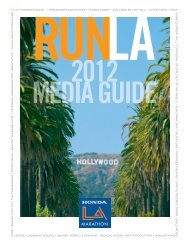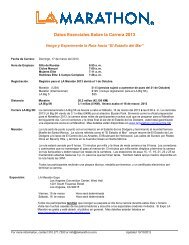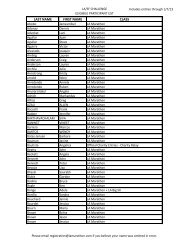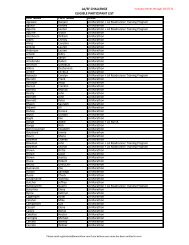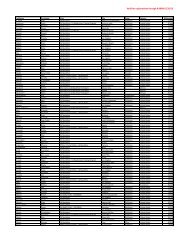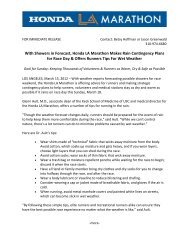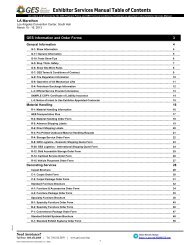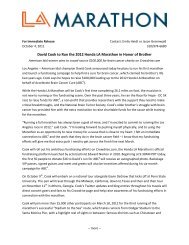2013 media guide - LA Marathon
2013 media guide - LA Marathon
2013 media guide - LA Marathon
Create successful ePaper yourself
Turn your PDF publications into a flip-book with our unique Google optimized e-Paper software.
ABOUT THE RACE<br />
ABOUT THE RACE<br />
Course Highlights <br />
Start: <br />
Dodger Stadium adjacent to Parking Lot G behind center field <br />
One of the icons of Los Angeles, Dodger Stadium opened on April 10, 1962 with an <br />
audience of 52,564 fans. The first privately financed baseball park since Yankee <br />
Stadium opened in 1923, it was designed by Capt. Emil Praeger and occupies 300 <br />
acres. The stadium seats 56,000 spectators for Dodger baseball games, and has also <br />
been home to several other historical events, including the 1984 Olympic baseball <br />
tournament, the 1987 Papal Mass with Pope John Paul II, and the “Encore! The <br />
Three Tenors” concert in 1994 with José Carreras, Plácido Domingo and Luciano <br />
Pavarotti. <br />
Mile 1: <br />
Ending at Sunset Boulevard, just north of Marion Avenue <br />
(Elevation change: -‐81 feet, from 505 to 425 feet; 1 turn) <br />
From the start, the runners head toward the Sunset Gate, exiting the Stadium onto <br />
Elysian Park Drive and then turning left on Sunset Boulevard, heading into <br />
downtown Los Angeles. <br />
Mile 2: <br />
Ending on North Broadway, just north of Sunset Boulevard <br />
(Elevation change: -‐119 feet, from 425 to 306 feet; 1 turn) <br />
On Sunset, the runners find themselves on a portion of historic Route 66, a major <br />
highway from the Midwest to Southern California during the first half of the 20 th<br />
century. Sunset Boulevard becomes Cesar E. Chavez Avenue past Figueroa Street, <br />
just before the runners turn left onto Broadway and head into Chinatown. <br />
Mile 3: <br />
Ending on Main Street, between Temple and 1st Streets <br />
(Elevation change: -‐18 feet, from 306 to 288 feet; 4 turns) <br />
The city’s Chinatown district was developed in the 1870s; to mark the entryway, the <br />
city erected the 25-‐foot-‐high Chinatown Gateway Monument (also known as the <br />
Twin Dragon Towers Gateway) in 2001. It cost $800,000 to build and was designed <br />
to symbolize luck, prosperity and longevity. <br />
The runners enter Chinatown under the Gateway, heading toward Alpine Street and <br />
the massive Dynasty Center shopping plaza before turning right in Alpine and <br />
another right on Spring Street. They will then exit Chinatown with a left onto Cesar <br />
E. Chavez Ave. <br />
As runners turn from Cesar E. Chavez Ave., they will see the El Pueblo de Los <br />
Angeles State Historic Park, the oldest settlement in Los Angeles, on Main Street. <br />
Los Angeles was founded in the fall of 1781 by its 44 original settlers, but the Old <br />
Plaza in El Pueblo Park dates from 1815. <br />
The oldest residence in the city that is still standing is the Avila Adobe (14 Olvera <br />
Street), which was built in 1818 on adjacent Olvera Street. The Plaza Church (535 <br />
North Main) was built by Franciscan fathers and Native Americans and opened in <br />
1822. The Pico House (430 North Main) was the city’s first masonry structure and <br />
was built as a hotel by Pio Pico, the last Mexican governor of Alta California (now <br />
the State of California). The current marketplace format of Olvera Street is a <br />
relatively new development, dating back from 1929. <br />
The Los Angeles Mall Civic Center complex sits on Main Street at Temple Street, <br />
marked by the six story 60-‐ton Triforium created by artist Joseph Young in 1975, <br />
which features 1,494 multicolored glass prisms. It was refurbished in 2006. <br />
Mile 4: <br />
Ending at 1st Street, just north of Spring Street <br />
(Elevation change: +2 feet, from 288 to 290 feet; 5 turns) <br />
Mile 4 courses through the heart of downtown Los Angeles, turning from 1 st Street <br />
onto Central Avenue and then beginning a long climb from Central Avenue & 2 nd<br />
Street to the top of Bunker Hill, then exiting out of downtown into Echo Park. <br />
This rise is 185 feet from Central Avenue (elevation 265 feet), up and out of <br />
downtown to Bellevue Avenue (elevation 450 feet) in Echo Park, between <br />
approximately the 3½ and the 5½-‐mile points. This is the largest and longest <br />
climb on the course. <br />
Los Angeles City Hall (200 North Spring Street) is a famous Art Deco skyscraper that <br />
stands 28 floors and 454 feet high. Built in 1928, the building became an icon <br />
through its appearances on television in the 1950s as the headquarters of the Daily <br />
Planet newspaper on “The Adventures of Superman” and in the 1960s on the series <br />
“Dragnet.” It was the tallest building in California from its completion until 1964, <br />
and the tallest in Los Angeles until 1968 (due to legal height restrictions in place <br />
until 1957). <br />
The new Police Administration Building (known informally as “Parker Center”) at <br />
Main & 1st Streets serves as the headquarters of the Los Angeles Police <br />
Department, and opened in October 2009. <br />
The course loops through Little Tokyo beginning at Los Angeles Street, one of three <br />
recognized “Japantowns” in the U.S. (the other two are in San Francisco and San <br />
Jose). It was founded in the early 1900s and declared a National Historic Landmark <br />
District in 1995. The route passes the Buddhist Temple (342 East 1 st Street, the first <br />
Shingon temple in North America) and the Japanese American National Museum <br />
(369 East 1 st Street), which opened in 1992. <br />
14 ASICS <strong>LA</strong> MARATHON<br />
MEDIA GUIDE<br />
15



